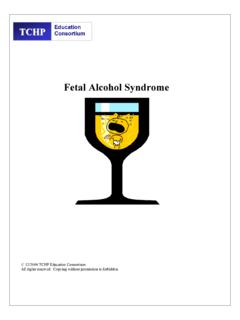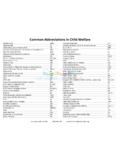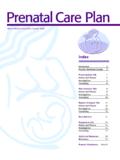Transcription of Fetal Alcohol Syndrome
1 Fetal Alcohol Syndrome : Guidelines for Referral and Diagnosis National Center on Birth Defects and Developmental Disabilities Centers for Disease Control and Prevention Department of Health and Human Services in coordination with National Task Force on Fetal Alcohol Syndrome and Fetal Alcohol Effect American Academy of Pediatrics American College of Obstetricians and Gynecologists March of Dimes National Organization on Fetal Alcohol Syndrome July 2004. (2nd printing, August 2004). (3rd printing, May 2005). DEPARTMENT OF HEALTH AND HUMAN SERVICES. Centers for Disease Control and Prevention Julie Louise Gerberding, , , Director National Center on Birth Defects and Developmental Disabilities Jos Cordero, , Director Division of Birth Defects and Developmental Disabilities Fetal Alcohol Syndrome Prevention Team R.
2 Louise Floyd, , , Team Leader Contents Acknowledgements ..iv Foreword ..v Executive Summary ..v Background ..1. Approach and Methods for Development of Guidelines ..4. Diagnostic and Referral Framework ..7. Diagnostic Criteria ..9. Criteria for FAS Diagnosis ..19. Considerations for a Referral for an FAS Diagnostic Evaluation ..21. Services Appropriate for Affected Individuals and their Families ..22. Identifying and Intervening with Women at Risk for an Alcohol -Exposed Pregnancy ..28. Summary and Future Steps ..37. References ..39. iii Acknowledgements National Task Force on Fetal Alcohol Syndrome and Fetal Alcohol Effect (NTFFAS/FAE): Kristen L., Barry, , Department of Veterans Affairs; James E. Berner, , Alaska Native Tribal Health Consortium; Raul Caetano, , , , University of Texas School of Public Health; Faye B.
3 Calhoun, , , NIAAA; Michael E. Charness, , Harvard Medical School; Deborah E. Cohen, , New Jersey Office for Prevention of Mental Retardation and Developmental Disabilities; Claire D. Coles, , Marcus Institute; Jos . Cordero, , NCBDDD; Chris Cunniff, , University of Arizona; Karla Damus, , , March of Dimes; Nancy L., Day, , University of Pittsburgh; Jocie C. Devries, FAS Family Resource Institute; Louise Floyd, , , NCBDDD; Mark B. Mengel, , , St. Louis University School of Medicine; Lisa Miller, , , Colorado Responds to Children with Special Needs; Kathleen T. Mitchell, MHS, LCADC, National Organization on FAS; Raquelle Myers, , National Indian Justice Center; Edward Riley, , San Diego State University; Luther K. Robinson, , SUNY Buffalo School of Medicine; Charles M.
4 Schad, , University of South Dakota; Robert J. Sokol, , Wayne State University; Daniel C. Vinson, , , University of Missouri; Jean A. Wright, , Backus Children's Hospital. Scientific Advisory Panel: Herb Bischoff, , Project Alaska; Julia M. Bledsoe, , University of Washington; Larry Burd, , North Dakota FAS Center; Tom Donaldson, National Organization on FAS; Daniel Dubovsky, , FAS Center for Excellence; Sheila Gahagan, , , University of Michigan; Marian Kummer, , National Committee of Children with Disabilities; Carole M. Lannon, , , National Initiative for Children's Healthcare Quality; Theresa Maresca, , Family Practice Physician; Sarah McGovern, , National Initiative for Children's Healthcare Quality; Uday C. Mehta, , , UMDNJ-RWJ.
5 Medical School; Colleen A. Morris, , University of Nevada School of Medicine; Rick L. Olson, , Greenwood Genetic Center; Natalie E. Roche, , New Jersey Medical School;. Thomas F. Tonninges, , , American Academy of Pediatrics. Scientific Working Group: Susan J. Astley, , University of Washington; Jacquelyn Bertrand, , NCBDDD; Heather Carmichael Olson, , University of Washington; Jocelynn L. Cook, , , Health Canada; Chris Cunniff, , University of Arizona; . Louise Floyd, , , NCBDDD; Lewis B. Holmes, , Massachusetts General Hospital for Children;. Kenneth Lyons Jones, , University of California School of Medicine; Kathleen T. Mitchell, MHS, LCADC, National Organization on FAS; Mary O'Connor, , University of California at Los Angeles; Edward Riley, , San Diego State University; Luther K.
6 Robinson, , SUNY Buffalo School of Medicine; Kenneth R. Warren, , NIAAA. Mary Kate Weber, , NCBDDD. CDC/NCBDDD Participants: Martha Alexander, , ; Hani K. Atrash, ; Jacquelyn Bertrand, ; Carol Cabal, ; Jos Cordero, ; Yvette Dominique, ; Larry Edmonds, ; Paul Fernoff, , ; R. Louise Floyd, , ; Connie Granoff;. Melissa Hogan. ; Karen Hymbaugh, ; Cynthia Moore, , ; Elizabeth Parra Dang, ; Jorge Rosenthal, , ; Tanya Sharpe, , ; Jasjeet Sidhu, , ; Mary Kate Weber, ; Marshalyn Yeargin-Allsopp, Prepared and edited by: Jacquelyn Bertrand, ; R. Louise Floyd, , ; Mary Kate Weber, ; Mary O'Connor, ; Kay A. Johnson, , ; Edward Riley, ;. Deborah E. Cohen, iv Foreword The National Center on Birth Defects and Developmental Disabilities at the Centers for Disease Control and Prevention, in collaboration with the National Task Force on Fetal Alcohol Syndrome and Fetal Alcohol Effect, is pleased to present Fetal Alcohol Syndrome : Guidelines for Referral and Diagnosis.
7 This document represents the deliberations of clinicians, researchers, parents, and repre . sentatives of governmental and non-governmental organizations, whose main goals were to increase the identification of individuals with Fetal Alcohol Syndrome (FAS) using uniform criteria, and to improve the delivery of appropriate services to those individuals and their families. These new guidelines will help achieve those goals by educating medical and allied health professionals about FAS. In 2003, we, in the FAS research and practice communities, celebrated the 30th anniversary of the first reports describing Fetal Alcohol Syndrome . Since that time we have learned a great deal about this preventable condition. We now recognize that FAS represents the tip of the iceberg and that there is a continuum of outcomes associated with prenatal exposure to Alcohol .
8 These guidelines were undertaken, in part, as an effort to facilitate further identification, understanding, and study of all conditions resulting from prenatal exposure to Alcohol . They build on previous work and incorporate important scientific and clinical knowledge that has been obtained in recent years. CDC is pleased to provide continuing support for the expansion and refinement of scientific descriptions for FAS and other disorders related to prenatal exposure to Alcohol through its ongoing work with the National Task Force on Fetal Alcohol Syndrome and Fetal Alcohol Effect and the federal Interagency Coordinating Committee on Fetal Alcohol Syndrome (ICCFAS). Preventing all adverse outcomes associated with prenatal Alcohol exposure remains a primary goal of CDC, as well as the entire Department of Health and Human Services.
9 CDC is committed to working with other federal agencies, organizations in the private sector, relevant partners, and the public to achieve this goal. Similarly, CDC is committed to enhanced early identification of indi . viduals with FAS and related disorders to ensure their access to appropriate services. These latest guidelines for referral and diagnosis are an important step towards that goal. Together we will ensure all persons with FAS and related disorders develop optimally and reach their full potential. Jos F. Cordero, , Assistant Surgeon General Director National Center on Birth Defects and Developmental Disabilities v Fetal Alcohol Syndrome : Guidelines for Referral and Diagnosis vi Fetal Alcohol Syndrome : Guidelines for Referral and Diagnosis EXECUTIVE SUMMARY.
10 As part of the fiscal year 2002 appropriations funding legislation, the Congress mandated that the Centers for Disease Control and Prevention (CDC), acting through the National Center on Birth Defects and Developmental Disabilities (NCBDDD) Fetal Alcohol Syndrome (FAS). Prevention Team and in coordination with the National Task Force on Fetal Alcohol Syndrome and Fetal Alcohol Effect (NTFFAS/FAE), other federally funded FAS programs, and appropriate non . governmental organizations, would: Develop guidelines for the diagnosis of FAS and other negative birth outcomes resulting from prenatal exposure to Alcohol , Incorporate these guidelines into curricula for medical and allied health students and practition . ers, and seek to have them fully recognized by professional organizations and accrediting boards, and Disseminate curricula to and provide training for medical and allied health students and practi.
















